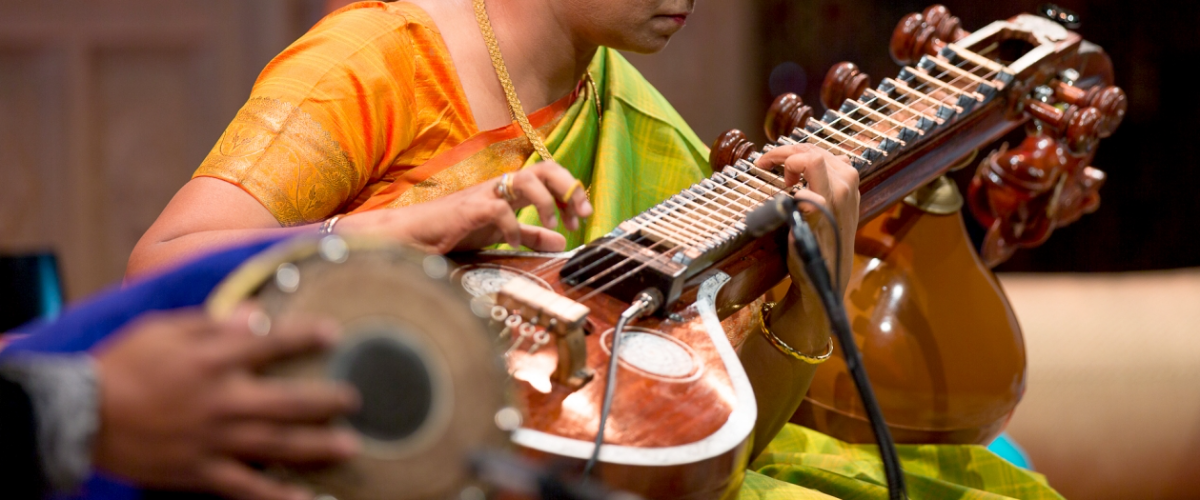

The veena is a large plucked lute and one of India’s oldest instruments with a recorded history going back to about 1500 BC. While it is getting rarer in North India, the veena remains a predominant solo instrument in the Carnatic music tradition, in South India, where it is known specifically as Saraswati veena, named after the goddess of art, music, and learning, who is usually depicted holding or playing the instrument.
It is sometimes also referred to as the Ragunatha veena, named after the 17th century Tamil Nadu King, Ragunath Nayak, during whose reign the district known as Thanjavar became a major centre for the arts, particularly music and dance. It was during this time that the formerly movable frets of the veena evolved into twenty-four fixed frets.
The main distinguishing factor between veenas in North and South India is that while the South’s Saraswati veena is a descendant of an early lute, the rudra veena and vichitra veena of the North are, technically speaking, related to zithers. Also, unlike its Northern counterpart which only figures in pure classical music, the veena of South India is used for contemporary as well as classical music.
The Saraswati veena is about four feet in length, consisting of a large resonator carved and hollowed out of a single log of jack wood, a tapering hollow neck topped with twenty-four brass or bell-metal frets and a tuning box ending in a curved slope which is topped off with an ornamental dragon's head. There are four main playing strings and three drone strings all made of metal.
It is played by sitting cross-legged with the instrument held at an angle and slightly away from the player. The small gourd on the left rests on the player's left thigh, with the left arm passing beneath the neck and bringing the hand curving up over it so that the fingers can rest upon the frets. The palm of the right hand rests on the edge of the top plank so that the index and middle fingers plucking the strings. The drone strings are played using the little finger.
The veena's large resonator rests on the floor, just near the player’s right thigh. As with the North Indian sitar, the left hand manipulates the frets with controlled pushing on the strings to produce higher-pitched tones and slides through increased tension. The chitra veena is another kind of veena played in South India. It looks almost exactly like the more widespread Saraswati veena but it does not have any frets. Also, unlike the Saraswati veena, the chitra veena also has sympathetic strings.
Listen to the music | Dr. Jayanthi Kumaresh, one of the world's foremost Saraswati veena players, discusses the history of her instrument (“The first veena...he made it using a human skill, with a bamboo stick...and a nerve used as a string...”).
Jameela Siddiqi is an author, linguist, and BBC cultural commentator, specialising in postcolonial fiction and the devotional music of South Asia.
Darbar believes in the power of Indian classical music to stir, thrill, and inspire. Explore our YouTube channel, or subscribe to the Darbar Concert Hall to watch extended festival performances, talk and documentaries in pristine HD and UHD quality.
The ghatam is a South Indian drum resembling a porous earthenware or clay pot, a common household object in North and...
Read More 
Exploring ten strange, beautiful instruments from India's classical traditions. By George Howlett | Part of Living...
Read More 
There are two kinds of Indian classical music, Hindustani (North Indian) and Carnatic (South Indian), descended from...
Read More 
The beginner's guide to Indian classical music. Whether you’re completely new to raga music or just need a refresher, we’ve put together this brief overview of all things raga music to help you feel at ease when visiting one of our concerts or watch our videos on our YouTube or our Darbar Concert Hall.

Keep up to date with the latest news, events, music and musings across our social channels
For hundreds more clips and shorts, vist our YT page here 
Be the first to hear before events go on sale. Get the latest news and articles from Darbar